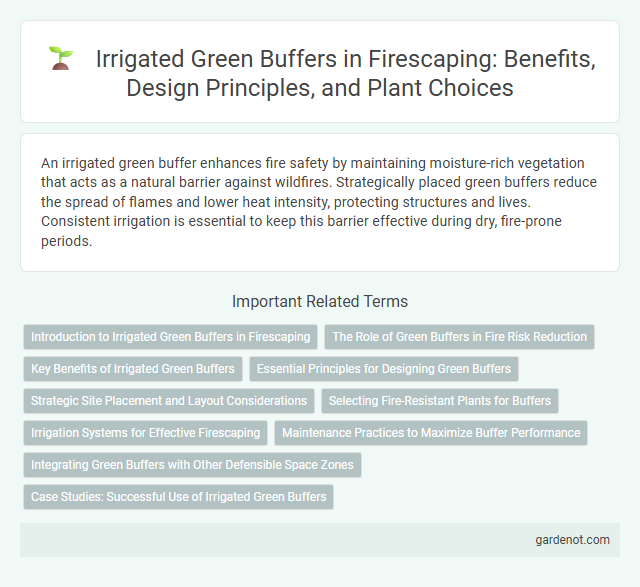An irrigated green buffer enhances fire safety by maintaining moisture-rich vegetation that acts as a natural barrier against wildfires. Strategically placed green buffers reduce the spread of flames and lower heat intensity, protecting structures and lives. Consistent irrigation is essential to keep this barrier effective during dry, fire-prone periods.
Introduction to Irrigated Green Buffers in Firescaping
Irrigated green buffers serve as vital defensible spaces in firescaping by maintaining lush, moisture-rich vegetation that resists ignition and slows wildfire spread. These buffers often include drought-tolerant, fire-resistant plants supported by controlled irrigation systems to ensure continuous hydration during dry seasons. Strategically placed around structures, irrigated green buffers reduce heat intensity and protect property by creating a moist barrier that disrupts fire pathways.
The Role of Green Buffers in Fire Risk Reduction
Irrigated green buffers serve as vital firebreaks by maintaining lush, moisture-rich vegetation that lowers the likelihood of wildfires spreading into residential areas. These strategically placed green buffers reduce fuel continuity, decrease heat intensity, and create safer zones for firefighters to operate effectively. Incorporating irrigation systems ensures consistent plant hydration, further mitigating fire risk in high-threat fire landscapes.
Key Benefits of Irrigated Green Buffers
Irrigated green buffers significantly reduce wildfire risk by maintaining moisture in vegetation, which lowers the likelihood of ignition and fire spread near structures. These buffers enhance air quality by trapping dust and smoke particles, creating a healthier environment for residents. Well-maintained irrigated green zones also contribute to soil stabilization, preventing erosion and protecting water resources in fire-prone areas.
Essential Principles for Designing Green Buffers
Irrigated green buffers serve as critical protective barriers in firescaping by utilizing moisture-rich vegetation to slow wildfire spread and reduce radiant heat. Essential principles for designing these green buffers include selecting drought-tolerant, fire-resistant plant species with high moisture content, ensuring consistent irrigation to maintain soil and plant hydration, and strategically placing the buffer to create defensible space between flammable structures and wildland areas. Proper soil preparation and regular maintenance further enhance the effectiveness of irrigated green buffers in mitigating fire risks.
Strategic Site Placement and Layout Considerations
Strategic site placement for irrigated green buffers involves positioning vegetation to create effective firebreaks that reduce wildfire intensity near structures. Layout considerations include selecting fire-resistant plant species arranged in staggered patterns to maximize moisture retention and minimize fuel continuity. Proper spacing and irrigation systems enhance the green buffer's ability to slow fire spread and protect property assets.
Selecting Fire-Resistant Plants for Buffers
Selecting fire-resistant plants for an irrigated green buffer involves choosing species with high moisture content, low resin and oil levels, and dense leaf structure to reduce flame spread. Native plants such as California lilac (Ceanothus spp.), manzanita (Arctostaphylos spp.), and succulents like aloe and agave are ideal for creating effective fire buffers. Proper irrigation maintains plant hydration, further enhancing the buffer's ability to slow wildfire intensity and protect property.
Irrigation Systems for Effective Firescaping
Irrigation systems play a crucial role in maintaining an irrigated green buffer that effectively reduces wildfire risks by sustaining healthy, moisture-rich vegetation. Drip irrigation and smart controllers optimize water use, ensuring consistent hydration to critical areas while minimizing waste. Properly designed irrigation networks enhance plant resilience against heat and flames, forming a reliable barrier in firescaping strategies.
Maintenance Practices to Maximize Buffer Performance
Regularly inspecting and maintaining irrigated green buffers ensures optimal water distribution and plant health, which enhances fire resistance. Implementing precise irrigation schedules tailored to local climate conditions prevents drought stress that can weaken vegetation and increase fire risk. Consistent pruning and removal of dead or diseased plant material reduce fuel loads, maintaining the buffer's effectiveness in fire mitigation.
Integrating Green Buffers with Other Defensible Space Zones
Irrigated green buffers serve as crucial fire-resistant zones by maintaining high moisture levels in vegetation, significantly reducing ignition risks near properties. Integrating these green buffers with adjacent defensible space zones, such as lean, clean, and green areas, creates layered protection that slows fire spread and aids firefighter access. Strategic placement of irrigated green buffers enhances overall landscape resilience, optimizing fire mitigation efforts while supporting ecosystem health.
Case Studies: Successful Use of Irrigated Green Buffers
Case studies demonstrate that irrigated green buffers effectively reduce wildfire damage by creating moisture-rich zones that slow fire spread near vulnerable properties. In regions like California, these buffers, composed of fire-resistant plant species maintained through automated irrigation systems, have significantly increased property survivability during wildfire events. Data from these studies indicate a 40-60% decrease in ember intrusion and flame intensity adjacent to irrigated green buffers compared to non-irrigated landscapes.
Irrigated green buffer Infographic

 gardenot.com
gardenot.com